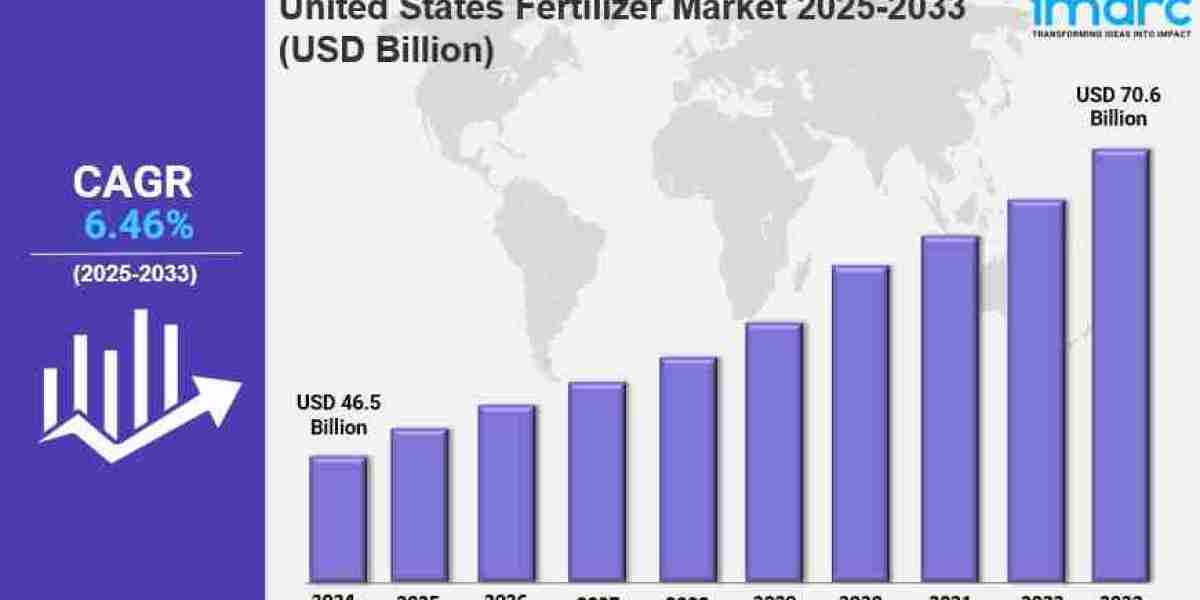Market Overview
The United States fertilizer market was valued at USD 46.5 Billion in 2024 and is projected to reach USD 70.6 Billion by 2033, growing at a CAGR of 6.46% during the forecast period of 2025-2033. Growth is driven by high agricultural productivity demands, advancements in fertilizer formulation technologies, and widespread adoption of precision farming. Key market segments include chemical and dry fertilizers, with grains and cereals as major consumers due to their extensive cultivation and nutrient needs.
Study Assumption Years
● Base Year: 2024
● Historical Year/Period: 2019-2024
● Forecast Year/Period: 2025-2033
United States Fertilizer Market Key Takeaways
● Current Market Size: USD 46.5 Billion in 2024
● CAGR: 6.46% from 2025 to 2033
● Forecast Period: 2025-2033
● Precision farming and sustainable farming are transforming fertilizer usage, with organic and bio-based products gaining traction.
● Government incentives, increased crop yields demand, and improved soil awareness drive market growth.
● Challenges include variable input prices, environmental concerns, regulatory pressure, and supply chain disruptions.
● Opportunities lie in green fertilizers, digital farming technologies, and local production enhancement.
● Growing demand for nutrient-enriched soils due to biofuel sector expansion boosts the market.
Sample Request Link: https://www.imarcgroup.com/united-states-fertilizer-market/requestsample
Market Growth Factors
The United States fertilizer market is primarily driven by the rising need to enhance agricultural productivity to meet the growing food demand. The 2024 population estimate of 340.1 million, reflecting about 1% growth from 2023, increases intensive cultivation practices, necessitating higher nutrient inputs to sustain soil fertility. Innovations in fertilizer formulations, including bio-based and controlled-release products, contribute to higher nutrient efficiency and reduced environmental impacts. Government initiatives promoting effective nutrient management and precision agriculture encourage adoption of modern fertilizers to improve yield and reduce waste.
Another significant growth factor is the expanding biofuel sector, which increases cultivation of feedstock crops such as soybeans and corn. As reported by the U.S. Energy Information Administration, U.S. renewable diesel and biofuel production capacity reached 4.3 billion gallons per year in January 2024, a rise of 1.3 billion gallons from 2023. This growth drives fertilizer demand to maintain soil health and crop development. Concurrent climatic fluctuations and soil degradation also promote demand for specialized fertilizers to bolster crop resilience.
Accelerating investments in agricultural research and development facilitate advancements in fertilizer products, enhancing market expansion. Growing demand for organic and specialty fertilizers is further supported by the consumer trend favoring sustainably sourced agricultural produce. Government support through incentives for sustainable farming adds momentum to adoption of bio-based and organic fertilizers. Advances in digital farming technologies, including GPS and soil sensors, optimize fertilizer application, improving nutrient efficiency and reducing environmental footprint.
Market Segmentation
By Product Type:
● Chemical Fertilizer: Dominates with around 98.9% market share in 2024, offering nutrient enhancements for large-scale farming through nitrogen, phosphorus, and potassium formulations.
● Biofertilizers: Noted as a segment but specific market share not provided.
By Product:
● Straight Fertilizers:
● Nitrogenous Fertilizers: Includes urea, calcium ammonium nitrate, ammonium nitrate, ammonium sulfate, anhydrous ammonia, and others; crucial for vegetative growth and yield enhancement.
● Phosphatic Fertilizers: Mono-ammonium phosphate (MAP), di-ammonium phosphate (DAP), single super phosphate (SSP), triple super phosphate (TSP), and others; important for root development and energy processes.
● Potash Fertilizers: Muriate of potash (MoP) and sulfate of potash (SoP); strengthen crop resilience and quality.
● Secondary Macronutrient Fertilizers: Calcium, magnesium, and sulfur fertilizers; address soil deficiencies and productivity.
● Micronutrient Fertilizers: Zinc, manganese, copper, iron, boron, molybdenum, and others; vital for optimal plant health.
● Complex Fertilizers: Included but detailed analysis not specified.
● Straight fertilizers hold roughly 71.0% market share in 2024.
By Product Form:
● Dry: Holds approximately 86.5% market share in 2024; popular due to cost-effectiveness, storage ease, and wide applicability with slow-release properties.
● Liquid: Present in the market; specific share not provided.
By Crop Type:
● Grains and Cereals: Lead with about 52.0% market share in 2024; major consumers include corn, wheat, and barley requiring significant nitrogen, phosphatic, and potash fertilizers.
● Pulses and Oilseeds: Included but specific details not provided.
● Fruits and Vegetables: Included; importance in specialty crop fertilization.
● Flowers and Ornamentals: Included with specific fertilizer requirements.
● Others: Additional crops included.
Regional Insights
The Midwest region dominates the United States fertilizer market due to extensive cultivation of grains and oilseeds such as corn and soybeans, driving high fertilizer demand. Nitrogenous fertilizers are predominant here, supporting cereal growth, while potash and phosphate fertilizers enhance crop quality and yield. Precision agriculture is widely adopted to optimize nutrient management. This region's leadership in row crop production secures its position as the largest fertilizer consumer in the country.
Speak to An Analyst: https://www.imarcgroup.com/request?type=report&id=19951&flag=C
Recent Developments & News
In January 2025, Michigan Potash secured a USD 1.26 billion loan from the U.S. Department of Energy to boost domestic natural fertilizer production. September 2024 saw Itafos expand into the Brazil market by opening an office in Bahia, contributing 20% of sales expected to rise to 30% by end of 2025. Also in September 2024, AdvanSix received a USD 12 million grant from the U.S. Department of Agriculture to support advanced fertilizer production and strengthen domestic supply chains. In August 2024, Phospholutions partnered with Toros Agri to begin commercial production of its phosphate-based RhizoSorb fertilizer.
Key Players
● CF Industries Holdings, Inc.
● Haifa Group
● ICL Group Ltd
● Koch Industries Inc.
● Nutrien Ltd.
● Sociedad Quimica y Minera de Chile SA
● The Andersons Inc.
● The Mosaic Company
● Wilbur-Ellis Company LLC
● Yara International ASA
If you require any specific information that is not covered currently within the scope of the report, we will provide the same as a part of the customization.
About Us
IMARC Group is a global management consulting firm that helps the world’s most ambitious changemakers to create a lasting impact. The company provide a comprehensive suite of market entry and expansion services. IMARC offerings include thorough market assessment, feasibility studies, company incorporation assistance, factory setup support, regulatory approvals and licensing navigation, branding, marketing and sales strategies, competitive landscape and benchmarking analyses, pricing and cost research, and procurement research.
Contact Us
IMARC Group,
134 N 4th St. Brooklyn, NY 11249, USA,
Email: sales@imarcgroup.com,
Tel No: (D) +91 120 433 0800,
United States: +1-201971-6302








